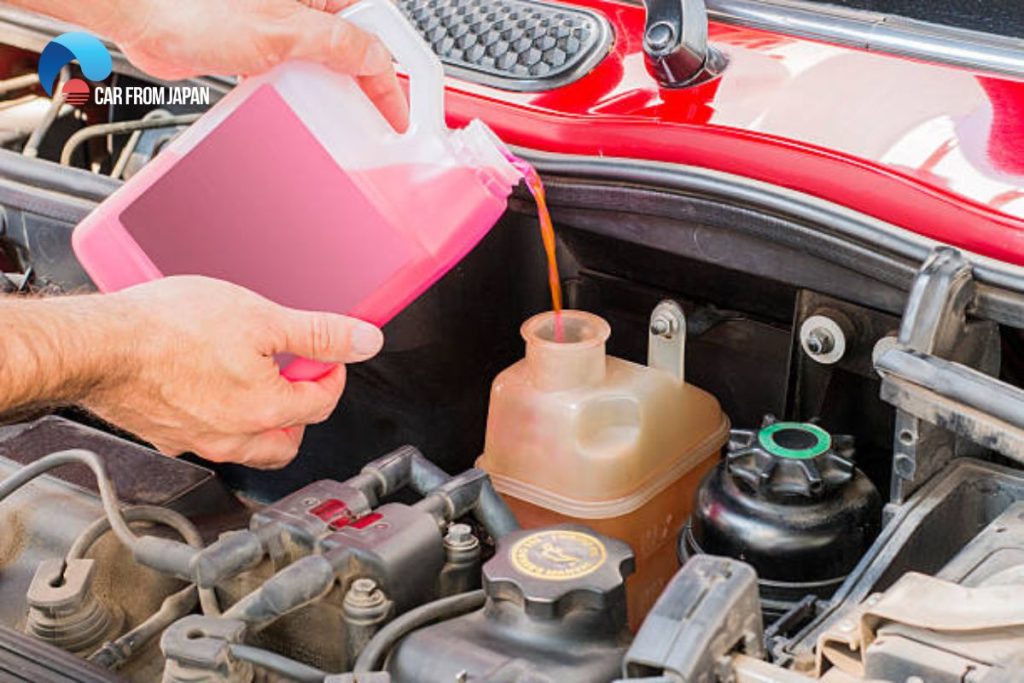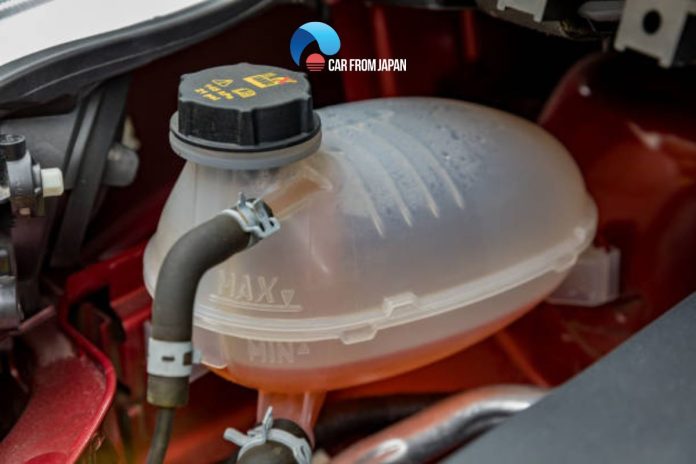A leaking radiator hose or a cracked water pump are the usual suspects when it comes to coolant loss. But what if you’ve thoroughly inspected your cooling system and found no signs of external leaks? This is where things get interesting. Coolant disappearing from reservoir without a visible leak often points to a more subtle, internal issue. This article will explore these hidden culprits, empowering you to diagnose and address the problem effectively.
Contents
- Why Is Coolant Disappearing From Reservoir Secretively?
- How To Fix The Coolant Disappearing From Reservoir?
- FAQs
- Why am I losing coolant but the engine is not overheating?
- How much coolant loss is considered normal?
- What happens if too much coolant is poured into the overflow?
- Will the radiator draw coolant from the reservoir?
- How frequently should you replace the coolant?
- What tool can you use to prevent or stop coolant leak?
Why Is Coolant Disappearing From Reservoir Secretively?
What does a coolant do? Coolant is not only a liquid that is useful in summer but winters as well.
Low coolant levels or running with aged coolant are common problems that are observable in cars.
The curiosity arises when the coolant mysteriously disappears from the reservoir, and you don’t even witness any leaks. How is that possible?
It is a baffling situation that has more to it than you could imagine. Let’s explore and get to the root cause of the problem at hand.
The real problem creeps in when the appropriate coolant levels are not maintained in the reservoir.
Such a decrease in coolant level is evident in the form of leaks or the smell that arises when coolant exits in the form of mist.
The real confusion arises when coolant disappearing from reservoir without any symptoms. What could be the reason for that? Let’s find out!

The faulty reservoir cap
There may be times when the reservoir radiator cap may turn out to be faulty. While this may seem to be a minor issue, it can lead to dire consequences.
In normal circumstances, the coolant gets released from the reservoir overflow tube the moment the engine starts warming up.
This leakage is visible and may result from a bad reservoir cap. Go through maintenance tips for the consequences of the overfilled coolant reservoir.
A reservoir is under pressure in normal circumstances in order to increase the coolant’s boiling point.
In case of a faulty radiator cap, the required pressure fails to build up inside the system, leading to overheating. When this happens, the coolant is likely to simply burn off rather than disappear.
Bad head gasket
A head gasket is a component that is sandwiched between the engine block and the cylindrical head within the combustion engine.
The basic functionality of these gaskets is to seal the cylinders so that the coolant does not find its way into the cylinders.
Sometimes, though, the head gasket can turn out to be defective. Such an issue, in turn, can lead to coolant flowing into the cylinder and evaporating.
In case the head gasket leak is a minor one, the air is likely to enter the coolant system.
The pressure thus formed by the air causes the radiator cap to lift up. This, in turn, leads to evaporation of the coolant along with the exhaust gases.

Invisible leakage points
When you have no idea where and why coolant disappearing from reservoir, conducting a pressure test can help solve the confusion.
You would require an air pump that, in turn, will help you detect the leakage point when nothing is visible to the eyes.
Remove the radiator cap and attach the air pump’s tester hose to the coolant recovery tank. Now, you can start pumping in the air until the air pump’s gauge reaches the level of pressure printed on the radiator.
Now that the system is pressurized, the leaks would be made visible through the leak points if any.
Leaking turbo seal
The majority of turbos are cooled by engine coolant. If a turbo seal fails and coolant leaks into the turbo, the coolant will escape through the exhaust.
Evaporation
Even though there is no visible leak on the ground, there might be a microscopic pin hole leak in one of the hose fittings. If the cooling system is not completely airtight, some coolant may slowly evaporate over time.
Sometimes there is a gradual leak that permits liquid coolant to seep out of the cooling system. When this happens, white streaks may appear at the site of the leak.
How To Fix The Coolant Disappearing From Reservoir?
Fixing coolant disappearing from your reservoir without visible leaks requires a systematic approach to pinpoint the hidden culprit. Here’s a step-by-step guide:
Rule out external leaks
Even if you haven’t spotted any puddles, double-check all hoses, clamps, the radiator, water pump, and thermostat housing for even the smallest signs of seepage. A pressure test can help reveal leaks that are difficult to spot visually.
Check the head gasket
A blown head gasket is a common cause of internal coolant loss. Look for signs like white smoke from the exhaust, milky oil, or bubbles in the coolant reservoir when the engine is running. A compression test or a chemical test kit can confirm a head gasket issue.
Inspect the intake manifold gasket
Similar to the head gasket, a leaking intake manifold gasket can allow coolant to seep into the engine’s combustion chambers. Look for signs of coolant residue around the intake manifold.
Consider a cracked cylinder head
In rare cases, a cracked cylinder head can lead to coolant loss. This often requires a professional inspection and may involve removing the cylinder head for examination.
Check the heater core
A leaking heater core can cause coolant to disappear without leaving visible traces. Look for signs of coolant inside the passenger compartment, especially under the dashboard.
Test the radiator cap

A faulty radiator cap can prevent the cooling system from maintaining proper pressure, leading to coolant loss. Replace the cap if it appears damaged or doesn’t hold pressure.
FAQs
Why am I losing coolant but the engine is not overheating?
It might be a broken hose or a radiator hole. Solution: Examine your hoses to determine if any coolant is leaking. If you find coolant flowing out of the hoses, replace them.
If you discover coolant leaking from your thermostat, it is a simple remedy.
How much coolant loss is considered normal?
If the engine is in good working order and there are no leaks or damage, you can expect a coolant loss of 0.25% every four to six months. This suggests that losing two to three ounces every year is perfectly normal.
What happens if too much coolant is poured into the overflow?
Excess coolant is usually evacuated by an overflow pipe. If this occurs, you will most likely see a pool of coolant beneath your vehicle.
Overfilling your antifreeze tank might cause electrical damage if the overflow comes into touch with engine wiring.
Will the radiator draw coolant from the reservoir?
The radiator cap enables some coolant to escape and be kept in the reservoir to relieve pressure. This extra coolant will remain in the system until the system cools sufficiently to produce negative pressure and pull the extra coolant from the reservoir back into circulation.
How frequently should you replace the coolant?
When the coolant level falls below the guidance markings, it should be topped up. Manufacturers’ recommendations for draining and replacing coolant vary.
However, depending on how old your automobile is, this might be after a minimum of 30,000 miles.
What tool can you use to prevent or stop coolant leak?
– Kit for detecting UV leaks
– Leak down examination
– Radiator pressure examination
Check out this video from 1A Auto to know how to diagnose a coolant leak in detail!




ssfsfd
What’s the answer to the question where does the water go there’s no leaks car doesn’t get hot you go around the question
as far as i know, the water can go into 2 areas… 1[thru the broken gasket, and into the pistion cylinders, then out the exhaust in puffs of white smoke[steam]… or 2]into the oil channels, into the oil pan… which turns the oil greyish white cuz of water and oil mixing and bubble s forming
I believe if your water disappear without leaking on the floor it could either leak into your engine via top gasket and this will be noticed if your oil change to a white color called sludge. Or it could leak into your engine also via top gasket but through a water port to combustion chamber. This will be noticed if your cars tail pipe gives off white smoke. If its not one of the two you can replace your radiator cap because sometimes the rubber is defective. If your water pump is shot it usually leaks and you will be able to see this immediately. Do not attempt to plug or stop this leak , change water pump and do not drive car in any of these cases unless problem is fixed. Remember every time your car overheat you damage it further until it just cannot go anymore.